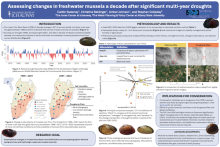Assessing changes in freshwater mussels a decade after significant multi-year droughts
Caitlin
Sweeney
The Jones Center at Ichauway
Christine Bahlinger, The Jones Center at Ichauway
Amber Johnson, The Jones Center at Ichauway
Steve Golladay, The Georgia Water Planning and Policy Center at Albany State University
Amber Johnson, The Jones Center at Ichauway
Steve Golladay, The Georgia Water Planning and Policy Center at Albany State University
Poster
Between 1999-2012, the Lower Flint River Basin in Georgia experienced three multi-year droughts. Surveys during the first drought in 2001 showed heavy declines of freshwater mussels in the Dougherty Plain physiographic district, while populations in the Fall Line Hills physiographic district remained stable. The basin has experienced less growing season water scarcity since 2013. We returned to historic sites in 2023 to assess mussel responses and determine the current distribution of listed species. Many sites in the Dougherty Plain showed increased mussel abundance and the return of listed species thought to be extirpated between 1999-2012. However, sites in the Fall Line Hills that showed resilience to the first multiyear drought showed much lower abundance in 2023. To investigate these observations, we summarized information on species functional traits and flow data from 2001-2023. We also used digital elevation maps to delineate stream valleys 1 km upstream from survey sites and aerial imagery to identify managed land (active forestry or agriculture) in the stream valleys. Streams in the Fall Line Hills had a well-developed dendritic drainage pattern with greater watershed area in stream valleys than the Dougherty Plain. They also had greater minimum flows, baseflow, and significantly greater managed area in the stream valleys than the Dougherty Plain. Additionally, the Dougherty Plain had greater variation in low flows and higher percentages of drought sensitive species. In a conservation context, efforts to prevent extreme growing season low flows in the Dougherty Plain will likely be effective. However, the geology of the Fall Line Hills makes its streams more prone to sediment inputs from soil erosion. In the field we observed large areas of coarse sand that represented poor mussel habitat. Thus, the declines we’ve observed in the Fall Line Hills may be related to excessive sedimentation. We suggest that additional conservation efforts reducing soil erosion may be required for mussel conservation in the Fall Line Hills.
Poster PDF

Meeting homepage